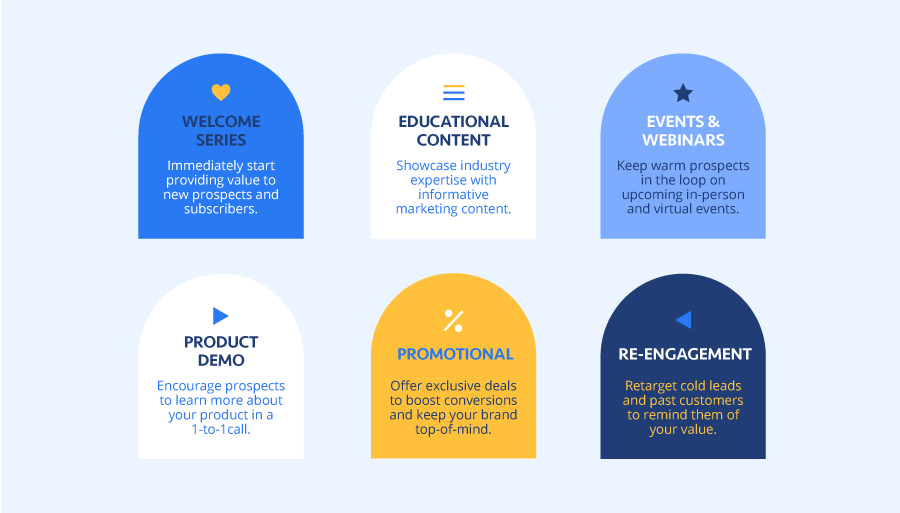Email marketing typically has among the highest ROI of any digital marketing branch. In fact, Litmus found that email marketing generates $42 for every $1 spent on average.
Email marketing is a branch of digital marketing that focuses on sending commercial messages to prospects’ and customers’ inboxes. There are many automation platforms that can be used for email marketing, such as Pardot, Marketo, Hubspot, and Mailchimp. Each platform is different and has its own unique features.
It’s important to understand the capabilities of your preferred platform and how to use them to automate tedious processes, such as segmenting audiences or grading leads.
Some of the most useful features that many platforms share are drip campaigns, lead scoring, dynamic lists, CRM integration, and automation rules.
Drip
campaigns
Drip campaigns are “self-contained” marketing campaigns that run on their own and are built using your desired logic and strategy.
With the assistance of marketing automation, the possibilities of drip campaigns appear almost endless. You can set up rules, triggers, and actions that will ensure the prospects journey is unique and perfectly catered.

The flowchart interface of drip campaigns make them easy to build and manage. When you get into planning each item for the campaign, they can perform a wide variety of actions to meet your marketing goals.
One of the most common drip campaigns is one that starts after form submission. If a prospect submits one of your forms to download a piece of content, you will know what kind of information that prospect is looking for, allowing you to create a drip campaign that follows up on the form submission.
Arguably the best part about drip campaigns is the hands-free nature of them. Once you start, you can just let them run their course since it is completely automated. If planned and scheduled correctly, no other emails will need to be created and added to the campaign.
Drip campaigns market to your prospects in the most efficient way possible and give you valuable data that can be used in future campaigns or to alter the current drip.

Download the B2B Guide to Marketing Automation
Don’t have time to read the whole guide right now? Download the PDF version of the guide.
Lead scoring &
grading
Lead scoring through a marketing automation platform allows you to score your leads based on how much they have interacted with your website, emails, and more. Lead grading, a related feature, lets you assign a letter grade to your prospects
Appropriately segmenting your audience and ranking your leads based on their level of interest can greatly increase the effectiveness of your marketing. And having your leads ranked by their alignment with your company’s buyer persona greatly reduces the amount of time needed to sort through contacts and gauge their qualifications manually.

The ideal prospect will have both a high lead score and high lead grade. Many companies use lead scoring to set a threshold of when a prospect can be considered a marketing-qualified lead.
For example, a prospect with a lead score of 50 can be automatically converted to MQL status and added to the sales queue for a follow up call.
Dynamic lists
Dynamic lists are lists of prospects that are updated automatically from a set of predetermined filters. These “living” lists can be used to add recipients to email campaigns, segment large lists of leads, and more.
Dynamic lists are important for targeting specific portions of your audience as they progress through your funnel. Marketers can cater content to these audiences without fear of it not being relevant to everyone on the list.
CRM integration
One of the most useful parts of marketing automation is how the different platforms integrate with CRMs such as Salesforce. Prospect data can be synced over to your preferred CRM without any manual input.
Prospects can be assigned to sales reps through a variety of dynamic processes such as scoring, grading, and automation rules. Sales reps can see how prospects have interacted with your marketing collateral, giving them greater insight into the buyer journey.
Automation
rules
Automation rules are advanced “if – then” statements that can be applied to a variety of automated processes inside your platform. For example, you can use an automation rule to:
- Add new prospects to a dynamic list
- Update fields on a prospect’s profile
- Send an autoresponder email
Automation rules allow for extremely targeted marketing. For example, you can establish criteria such as “if the prospect is from Texas and they have completed ‘X’ form on the website, then send them ‘Y’ email and add them to ‘Z’ list.”
Endless possibilities for B2B email marketing
Lead scoring, dynamic lists, CRM integration, and automation rules are just a few of the useful features in email automation platforms that can filter your audience as you guide them through your email campaigns.
Utilizing the comprehensive capabilities of your email marketing platform is an excellent example of how an automation tool can not only enhance your marketing ROI, but cut down the scope of error if exercised appropriately.


